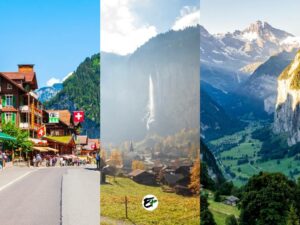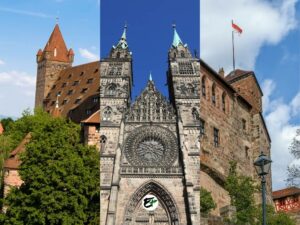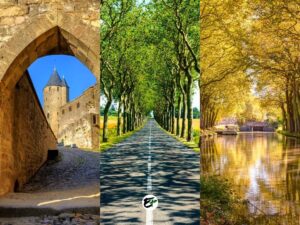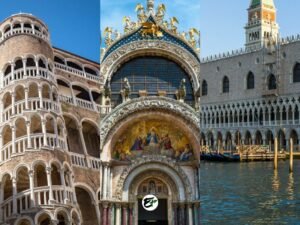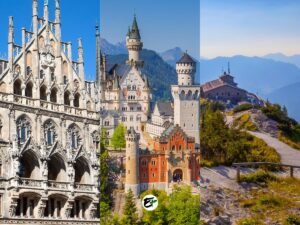10 Unmissable Beautiful Places to Visit in Florence
Home to some of the most recognizable artworks and architectural marvels in the world, Florence offers an unparalleled visual experience that’s no short of inspiring.
From the architectural complexity of the Florence’s landmarks and the immeasurable ingenuity in them to the details and realism in the Renaissance artworks inside Florence’s museums, as a person who travels to seek beauty, Florence is a dream come true.
In this blog post, I’m going to share with you all 10 beautiful places in Florence which are also the ones you should not miss if you’re traveling to this beautiful city.
Let’s get started!
This post contains affiliate links. I may receive a tiny commission at no additional cost to you.

Use the table of contents to skip to topics.
Florence is one of the most noteworthy travel destinations I know of if you’re looking for beauty. It is the birthplace of the Renaissance and the treasure trove of some of the most renowned artworks in the world.
Starting from Michelangelo’s David, a symbol of strength and human beauty in Accademia Gallery, to Botticelli’s Birth of Venus in the Uffizi Gallery. And don’t get me started on the architecture – Florence Cathedral, with its iconic Brunelleschi’s Dome, is just the tip of the iceberg.
Florentine architecture is celebrated throughout the world. And I know this personally because it’s what the architecture enthusiasts from all over the world on Twitter or X keep sharing all the time!
One of the things I learned from these architecture enthusiasts, which I strongly agree with, is that beauty is only subjective in the realm of objective beauty. It’s the kind of beauty that artworks and landmarks in Florence possess. If there are 10 places in Florence where you can easily find “real beauty,” they’re the ones I’ll show you below.
If you’re visiting Florence, you can check all the best things to do in Florence here. And if you need a place to stay, here’s where you can find the best hotel deals in Florence.
1. Florence Cathedral
To start off our list, we have the Florence Cathedral – a breathtaking structure that truly showcases the beauty of the city. The intricate exteriors, made up of polychrome white, pink, and green marbles, are sure to leave a lasting impression once you see it in person.
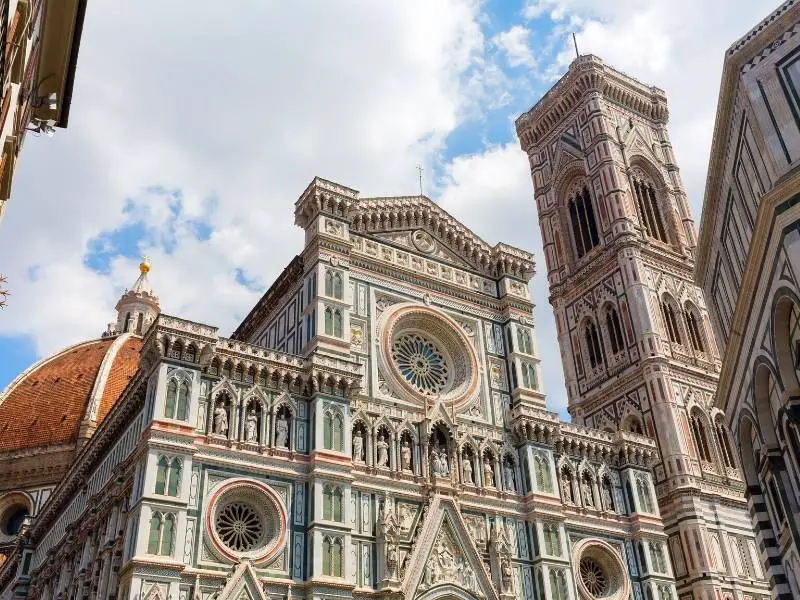
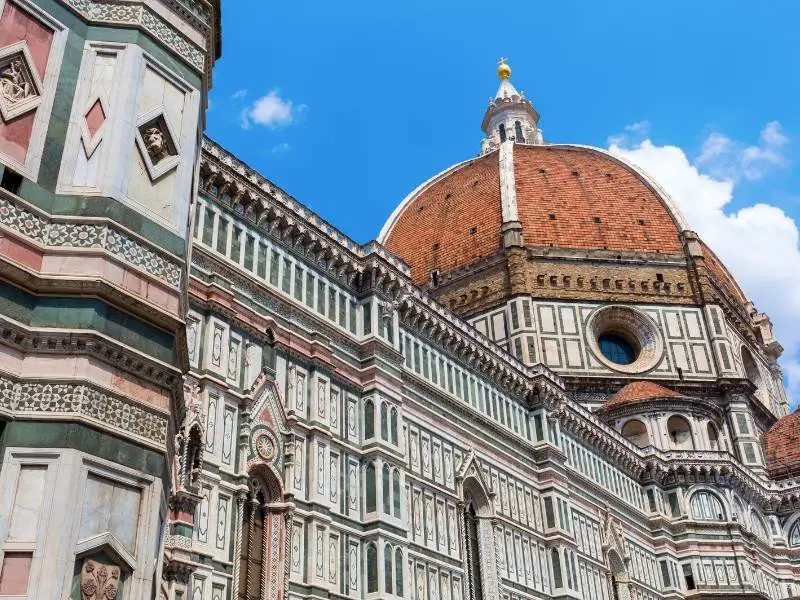
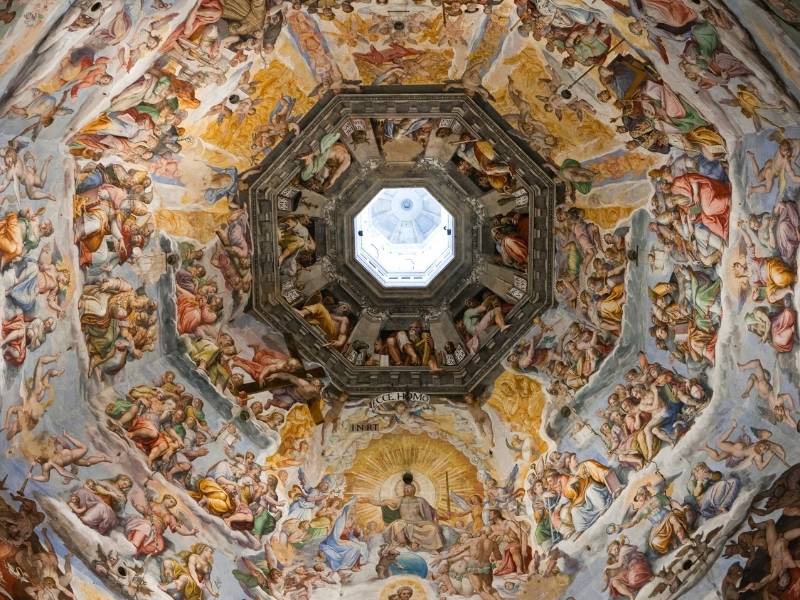
Located in the heart of Florence’s historic city center, this UNESCO World Heritage site since 1982 will leave you in awe with its stunning geometric patterns, mesmerizing color combinations, and outstanding craftsmanship.
Trust me when we say that no words can truly describe the beauty of this magnificent masterpiece. And just when you thought it couldn’t get any better, wait until you lay your eyes on its 19th-century facade – it’s an overwhelmingly gracious sight that will leave you speechless.
Beyond its elaborate facade and mesmerizing exteriors, Florence Cathedral features a remarkable dome. Both inside and out, the dome is a sight to behold. This incredible feat of Renaissance engineering isn’t just a symbol of Florence, but a testament to the creativity and ingenuity of the human mind.
As you tilt your head back to take in its grandeur, you’ll be struck by its sheer size. Standing at a towering 374 feet, it’s the largest masonry vault in the world – an architectural wonder that’s sure to leave you in awe.
But there’s more to this dome than meets the eye. Built between 1418 and 1434, during a time when Florence was a flourishing hub of art, science, and humanism, the dome is a testament to the city’s intellectual and cultural achievements.
Brunelleschi’s groundbreaking design and construction techniques allowed him to create this masterpiece without the need for a typical dome-building buttress. And the dome’s symbolism is just as striking as its physical presence: it stands out against the rest of the Florentine skyline, much like Catholicism stands out amongst the other religions in Florence.
It’s a powerful statement that speaks to the city’s cultural and religious identity.
If you’re interested in visiting Florence Cathedral, it’s important to note that on Sundays, it’s mostly reserved for religious and cultural activities. As a result, most parts of the church will be closed to tourists. However, if you’re planning on visiting during the week, from Monday to Saturday, you’ll be able to explore the church.
Just keep in mind that opening hours can vary, but generally, you’ll be able to visit anytime between 10:00 am to 4:30 pm. To ensure you have the most accurate information on visiting hours, it’s best to check the official website of Florence Cathedral on the date of your visit.
Additionally, the entry fee will depend on the type of pass you purchase. For more information on visiting the cathedral and other nearby landmarks, check out the links below.
If the widget is not working you may book your visit to different attractions in Florence here.
2. Baptistery
The Baptistery, situated in front of the Florence Cathedral, is an ancient structure that adds to the city’s beauty. Although it may appear small compared to the colossal Florence Cathedral, it is a fascinating structure that beautifully blends faith, history, architecture, and art.
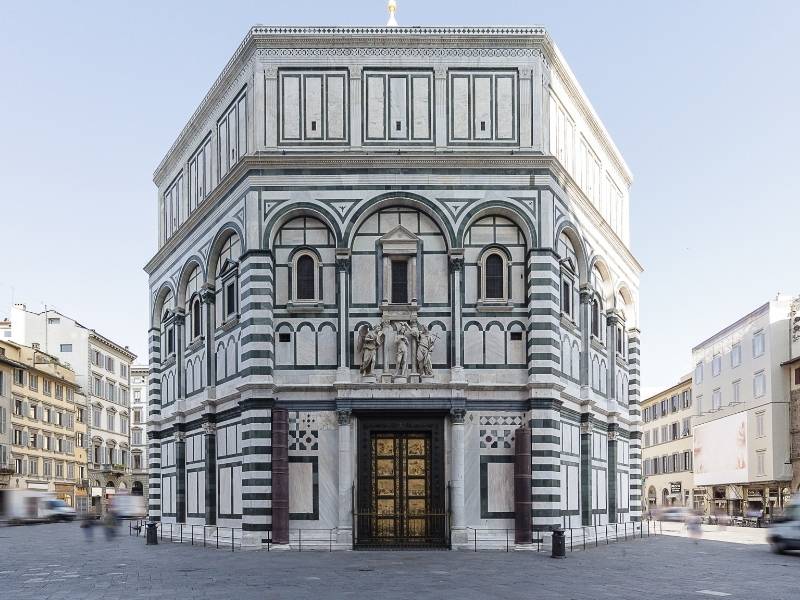
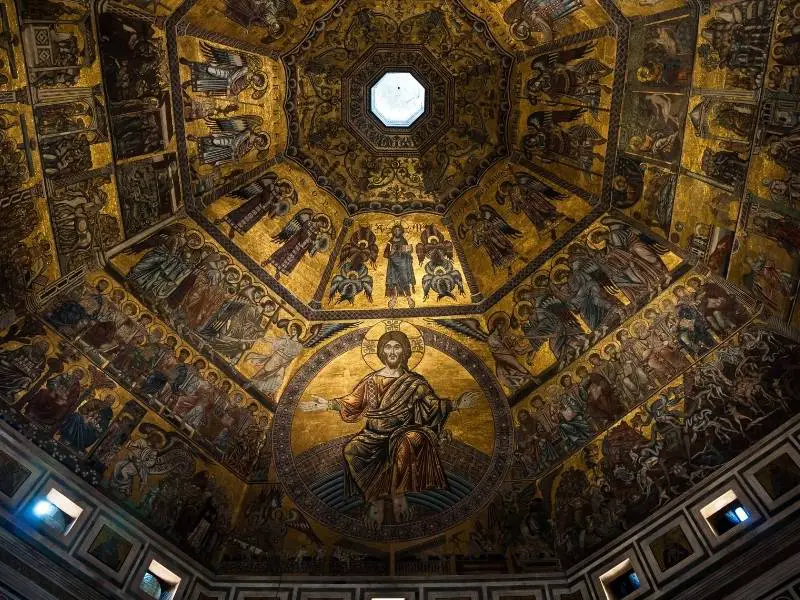

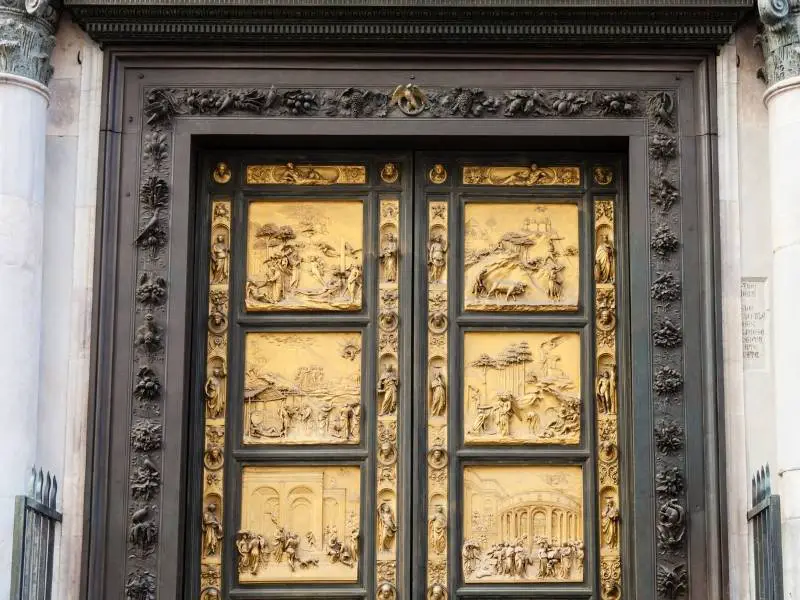
The Battistero di San Giovanni is the Italian name for the Baptistery.
Although it bears the name of a Christian saint, it may come as a surprise to learn that it was actually a pagan temple in its earlier days. If you’re interested in the history of Roman Florentia, be sure to examine the marble cladding and column inscriptions of the baptistry. These features date back several centuries around 4th and 5th centuries, though much of the structure has been converted and renovated since then.
While the exterior of the baptistry is less ornate than Florence Cathedral, the interior is a true masterpiece that embodies the beauty of Florence.
Battistero di San Giovanni is known for two things. The first are the bronze doors that adorn the north, south, and east facades of the building. The most remarkable among them is the East door, also known as the “Gates of Paradise.” This masterpiece from the Renaissance period was crafted by Ghiberti and features several panels with bas relief, depicting scenes from the Bible.
The Baptistery in Florence is truly a masterpiece, with one of its most notable features being the golden mosaic ceiling found inside its octagonal dome – the second thing Battistero di San Giovanni is famous for. The dome is adorned with intricate mosaics, arranged in concentric circles.
These mosaics depict a visual narrative of Christian theology, including scenes from Genesis, Joseph, Virgin Mary, Christ, and St. John the Baptist. The Last Judgment, created by Coppo di Marcovaldo, is the most famous of these. The use of gold in the mosaics makes them glitter and shine, adding to the ethereal atmosphere inside the Baptistery.
The mosaic’s depiction of biblical stories, starting from the Creation story and culminating in the end of the world with Christ from the Last Judgement, is truly impressive.
Do you want to visit Battistero di San Giovanni? The visiting information should be the same as Florence Cathedral. You can check the opening hours of the Baptistery from the Florence Cathedral’s official website.
3. Basilica of Santa Croce
Florence’s beauty shines through another remarkable site, the Basilica of Santa Croce, which is known as the world’s largest Franciscan church. This magnificent temple is also referred to as the “Temple of the Italian Glories” because it is the final resting place for some of the most celebrated Italian personalities like Michelangelo, Galileo, Dante, and Machiavelli.
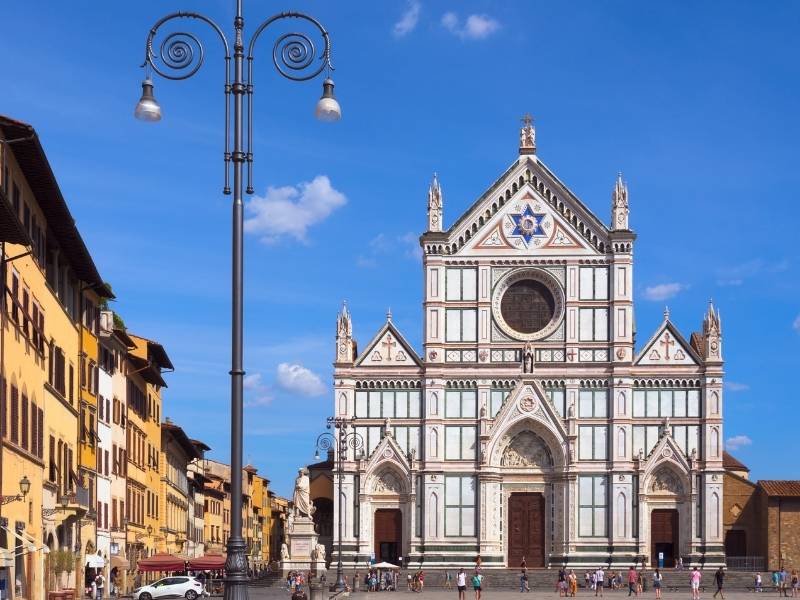

The Basilica of Santa Croce is situated in Piazza del Croce, 900 meters away from Piazza del Duomo. On the eastern side of the square, it stands out like a white jewel amidst pastel brown houses.
Upon entering this grand church, you will be immersed in nearly 4,000 works of art, each one a testament to Florence’s rich cultural heritage. Not a single inch, particularly the choir, is empty. It’s filled with either geometric elaboration or religious paintings adorning every surface!
One of the first things to catch your attention will be the frescos by Giotto. These masterpieces perfectly encapsulate the innovative 14th-century Florentine art style and content. Comparing Giotto’s work to the Bardi Altarpiece attributed to Coppo di Marcovaldo and Cimabue’s Crucifix, you can’t help but marvel at the change in artistic expression.
As you continue your exploration, your eyes will be drawn to Benedetto da Maiano’s marble pulpit. This stunning piece of Renaissance sculpture showcases the artist’s skill and craftsmanship, with intricate details etched into the marble that are a sight to behold.
Perhaps, the most captivating piece in the Basilica is Donatello’s Annunciation. This high-relief artwork showcases Donatello’s mastery in handling different materials, with delicate interplay of light and shadow that brings the scene to life. It will feel as if Mary and the angel Gabriel are right there in front of you.
Like Florence Cathedral, the Basilica of Santa Croce is within a complex you can visit when you buy an entry ticket.
Opening hours are from 9:30 am to 5:30 pm (last entry 5:00 pm) from Monday to Saturday except for Tuesday. During Sunday and religious holidays, tours are only allowed in the afternoon from 1:00 pm to 5:30 pm.
If you plan to visit, make sure to read the announcements/reminders indicated on the “visit page” of the official website of Santa Croce Basilica. The schedule for holiday closures, how to buy a ticket, and other services are well explained in the link I shared.
Save time on your trip to Florence by booking your passes to different attractions in advance. You can book your visit to the Basilica of Santa Croce below.
If the widget is not working you may book your visit to different attractions in Florence here.
4. Basilica of Santa Maria Novella
Yep, Florence is full of beautiful churches, and Santa Maria Novella Basilica is certainly no exception! Located just half a kilometer west of Piazza del Duomo, this stunning basilica boasts an impressive marble facade with eye-catching geometric patterns that are sure to amaze you. Make sure to stroll through the lovely garden in front of the basilica as well, to fully appreciate its beauty.
Here is the basilica’s exact location in Florence.
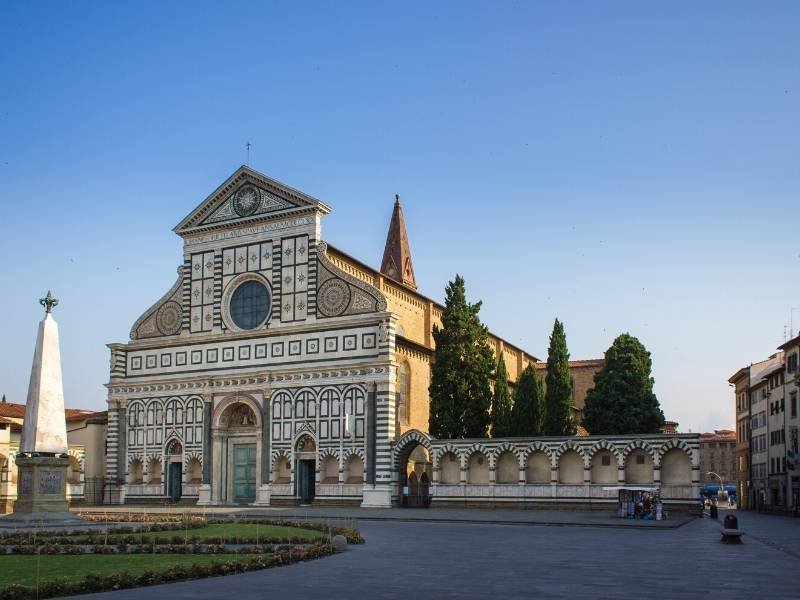

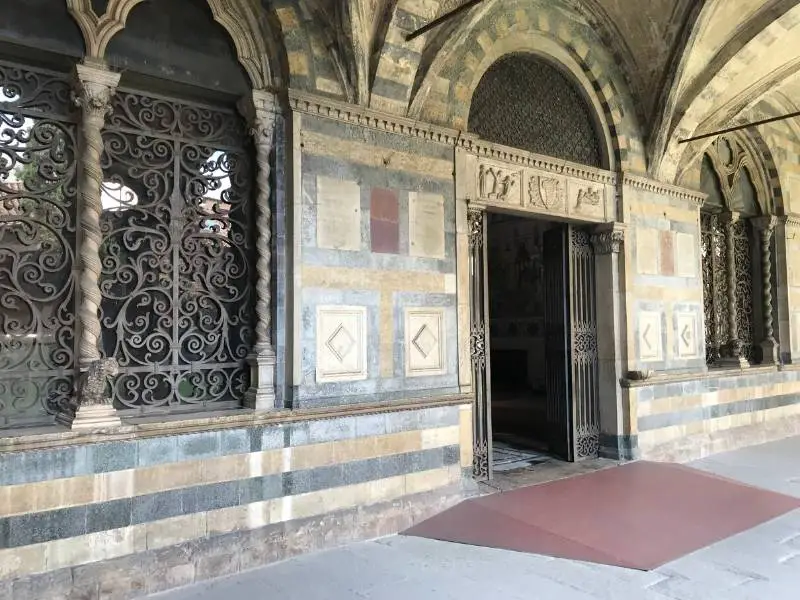
The Basilica of Santa Maria Novella, a 13th-century church, is the first great basilica of Florence. From gothic to early renaissance painters, numerous art treasures and frescoes are housed within it. You’ll be amazed by the basilica’s trompe-l’œil decorations, which are so lifelike that you might need to do a double take to confirm whether they’re a painting or relief.
The Gothic architecture of the nave may give the impression of being plain, but take a closer look at the black and white patterns that adorn the space. These alternating patterns give it a unique charm that’s hard to miss. Remember, there’s more to see beyond the nave – the true beauty lies at the altar and in the church’s chapels.
As mentioned earlier, the Basilica of Santa Maria Novella is home to a vast collection of artworks, primarily located in the chapels and altar. The first artwork visitors are likely to notice is the choir. This stunning piece is similar to the choir in the Basilica of Santa Croce, as both are covered in magnificent murals that leave no space untouched.
The Basilica of Santa Maria Novella boasts several chapels, but two that are definitely worth seeing are the Spanish Chapel and Filippo Strozzi Chapel.
If you’re looking for the Spanish Chapel, it’s situated on the north side of the Green Cloister. As for the Filippo Strozzi Chapel, you can find it on the right (east) transept. Filippo Strozzi Chapel definitely has the most monumental murals and trompe-l’œil inside the Basilica of Santa Maria Novella.
The chapel houses some of the most impressive murals, including St John the Evangelist Resuscitating Druisana, St Philip Driving the Dragon from the Temple of Hieropolis, Crucifixion of St Philip, and The Torture of St John the Evangelist. The paintings are so intricate that words can hardly do them justice.
The Spanish Chapel, on the other hand, has massive murals holding more than one story in it. The most famous mural in the chapel is known as the “Allegory of the Active and Triumphant Church and of the Dominican order.” This painting dates back to the mid-14th-century and shows the lives of the clergy, with the image of Christ during the Last Judgement gazing down upon them.
You must also see the cloister of the Basilica of Santa Maria Novella. The fading murals and overall ancient appearance of this place should really make you feel like you’ve gone back in time. Not to mention, the view and grassy courtyard make for an amazing photo opportunity, especially when the sun is shining strong.
Regarding opening hours, the church has different opening hours for different months. Take a look at the table below:
| Months | Monday to Thursday | Friday | Saturday & days before religious holidays | Sunday & religious holidays |
|---|---|---|---|---|
| April – June | 9:30 am to 5:30 pm | 11:00 am to 5:30 pm | 9:30 am to 5:30 pm | 1:00 pm to 5:30 pm |
| July – September | 9:30 am to 5:30 pm | 11:00 am to 5:30 pm | 9:30 am to 5:30 pm | 12:00 pm to 5:30 pm |
| October – March | 9:30 am to 5:00 pm | 11:00 am to 5:30 pm | 9:30 am to 5:00 pm | 1:00 pm to 5:30 pm |
Check for special announcements, holidays, and requirements before visiting the basilica from its official website. You can book your visit to Basilica of Santa Maria Novella using the widget below:
If the widget is not working you may book your visit to different attractions in Florence here.
5. Palazzo Medici Riccardi
As we explored the churches of Florence, we discovered that their magnificent architecture and art perfectly capture the city’s beauty. While this is undoubtedly true, we can further highlight Florence’s beauty by exploring the grand palaces within the city. One such palace worth exploring is the Palazzo Medici Riccardi.

If you’re looking for an eye-catching glimpse into the Renaissance period, you’ll find it in Palazzo Medici Riccardi – a government office that’s housed in a stunning palace located just 250 meters north of Florence Cathedral.
Via de Martelli connects the palace to Piazza del Duomo, making it easily accessible to visitors. Besides being a government office, Palazzo Medici Riccardi also boasts a famous chapel and art museum filled with superb Renaissance murals, paintings, and sculptures.
But you don’t have to go inside to experience the beauty of this palace. Michelozzo, an architect and pioneer of Renaissance architecture, designed its unique exteriors, which are a sight to behold.
Even though the Palazzo Medici Riccardi museum is comparatively small compared to the grandiose Palazzo Pitti and Uffizi Gallery, you’ll be amazed by the impressive artworks scattered throughout the building, from the doorways to the courtyard.
The palace itself is a masterpiece, with three floors housing both permanent and temporary exhibits, including Renaissance frescoes, paintings, archaeology, and marble sculptures. The first floor is the most exciting, as it features the majority of the Renaissance artworks.
If you’re a fan of archaeology and love admiring the skillful craftsmanship of ancient marble sculptures, head on down to the underground floor.
However, if you’re more interested in capturing Instagram-worthy scenes, the ground floor is where it’s at! Featuring the stunning Michelozzo Courtyard and Medici Garden, you’ll be sure to find plenty of picturesque scenes to snap and share with your followers. On the first floor, you have 10 rooms to explore.
When you visit, there is a straightforward route you will follow. You’ll pass by rooms with two doors, one leading to another. The tour of the first floor of the Palazzo Medici Riccardi begins at a tiny yet remarkable Magi Chapel, where elegance envelops you. From the golden ceiling of inlaid wood, to the geometric floor mosaics and carved wooden stalls – you’ll be awed by the intricate beauty of it all.
Details – they’re the most special about the murals in Magi Chapel.
The East and west walls of the chapel have exceptionally detailed paintings depicting a procession led by the three kings, Melchior, Balthasar, and Caspar. The most breathtaking artworks in Palazzo Medici Riccardi await you in the first floor’s last two rooms.
There you will find the eye-catching painting of Filippo Lippi, Madonna With Child, and the breathtaking frescoes by Luca Giordano. The frescoes depict the Apotheosis of the Medici – and it shall keep your jaws on the floor as your eyes wander on it.
I prefer not to share photos (and don’t search for them) to excite you to visit “the beautiful Florence.”
Palazzo Medici Riccardi is open to the public all week from 9:00 am to 7:00 pm except Wednesday. Tickets for “Museum + Exhibit” cost 10 EUR and 6 EUR for Museum only. Don’t forget to check for announcements and some requirements from the official website of Palazzo Medici Riccardi before you visit!
6. Palazzo Vecchio
When in Florence, you can’t miss visiting Palazzo Vecchio, the tallest structure in the city. This magnificent palace, along with Palazzo Medici Riccardi, showcases the exquisite beauty of Florence. A 13th-century fortification turned into a museum, Palazzo Vecchio is adorned with ornate decorations and houses an impressive collection of artworks that are a feast for the eyes.
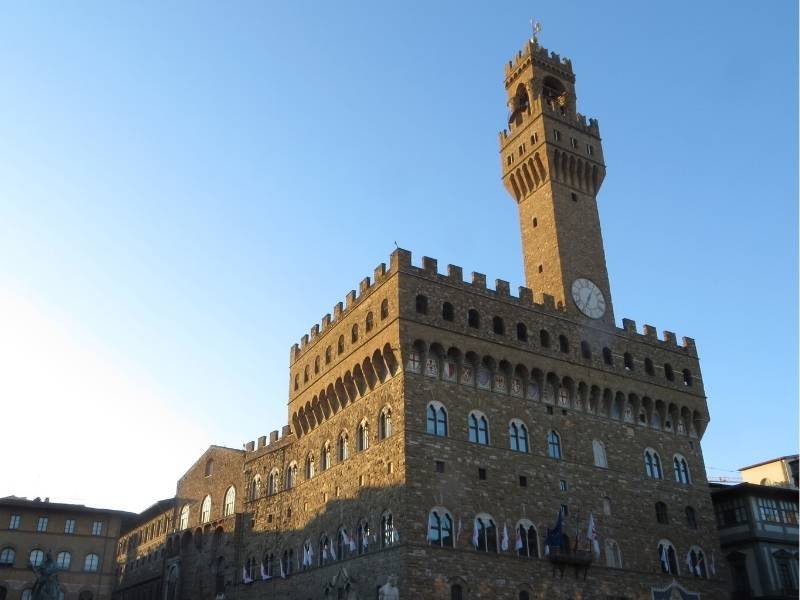
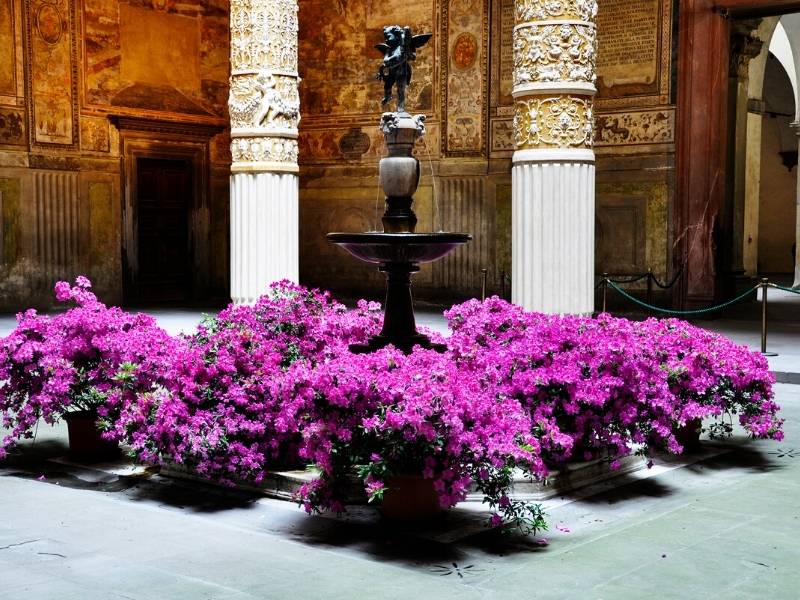
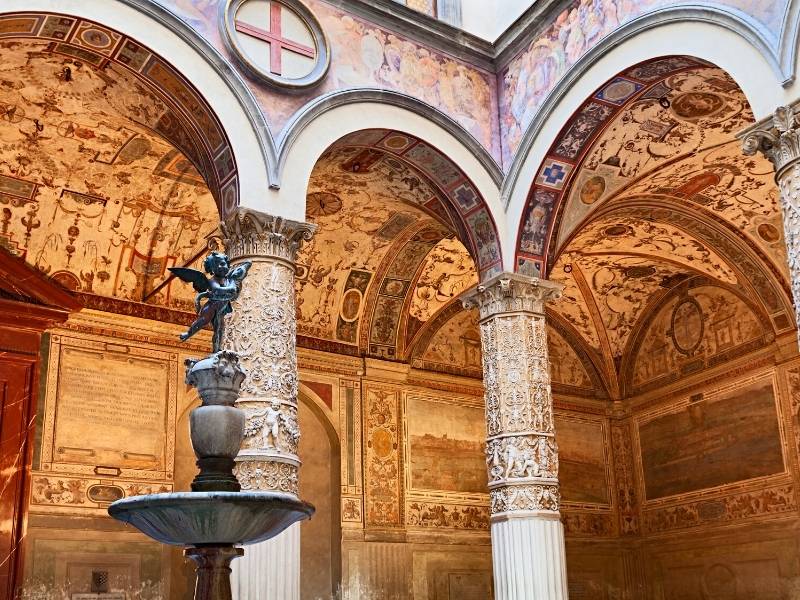

You can find Palazzo Vecchio in Piazza Della Signoria, 500 meters south of Piazza del Duomo, through Via dei Calzaiuoli. When you visit Piazza Della Signoria, you’ll come across Florence’s other renowned landmarks, such as the Equestrian statue of Cosimo I, Fontana del Nettuno and the Replica of the Statue of David.
Standing in the piazza, you will be able to see Palazzo Vecchio in its original state, a fortified fortress with battlements and high-precision archers guarding its windows. The building’s remarkable state of preservation is so immersive that it will transport you back to centuries past.
Palazzo Vecchio looks intimidatingly imposing outside, but how about inside? Get ready to be awestruck by the remarkable grandeur that awaits you. This is especially true when you visit the Hall of The Five Hundred, the largest room in Italy specifically built for a civil power palace.
The walls of this grand hall are adorned with expansive paintings that depict Florence’s victories over Pisa and Siena. If you look upwards, you’ll be treated to the sight of a magnificent ceiling, consisting of 39 splendid panels that showcase the Great Episodes from the life of Cosimo I – all of which are breathtaking works of art painted by Vasari and his assistants.
After visiting this hall, you’ll undoubtedly agree that Florence is a truly beautiful city.
The Palazzo Vecchio is home to several lavishly adorned rooms, but the Hall of the Five Hundred is the most impressive of them all. The palace is divided into three apartments, with each having five to seven rooms. These rooms are filled with sculptures, antiques, frescoes, and fleurs-de-lis decorated ceilings.
Just like the Palazzo Medici Riccardi, the Palazzo Vecchio boasts three stunning courtyards; the First, Second, and Third Courtyards.
Of these courtyards, the First Courtyard designed by Michelozzo is a must-see. The First Courtyard is a sight to behold, with its ornate pillars and stunning arcades. As you stroll through this beautiful space, you’ll notice the intricate stuccoes and frescoes that decorate the pillars. And if you take a closer look at the walls, you’ll see the fascinating frescoes that depict the cities of Austria during Habsburg Rule.
The museum in Palazzo Vecchio is open all days of the week. Every Thursday, you can only enter the museum from 9:00 am until 2:00 pm. But, for the rest of the week, the museum is open from 9:00 am until 7:00 pm.
The ticket office closes 1 hour before the closing hour.
You can also go inside Torre di Arnolfo, which has the same opening hours as the museum. It just closes earlier, by 5:00 pm. Most importantly, there is no access to the tower when it rains.
Before you visit, make sure to read the announcement from the website, cultura.commune.fi.it. Sometimes The Hall of the Five Hundred isn’t available for tours because it will be used for some events. Below are the different ways you can explore Florence with Palazzo Vecchio. Click to learn more:
Book your visit to Palazzo Vecchio in advance (and without hassle) using the widget below:
If the widgets are not working you may book your visit to different attractions in Florence here.
7. Palazzo Pitti
Florence’s beauty extends beyond its historic city center. Just cross the Arno River and you’ll find the magnificent Palazzo Pitti. This Renaissance palace showcases countless European and Italian masterpieces. Its unique rusticated stonework is an epitome of magnificent Italian Renaissance architecture.
It’s hard not to admire Palazzo Pitti’s beauty, making it a must-see attraction for anyone visiting Florence.
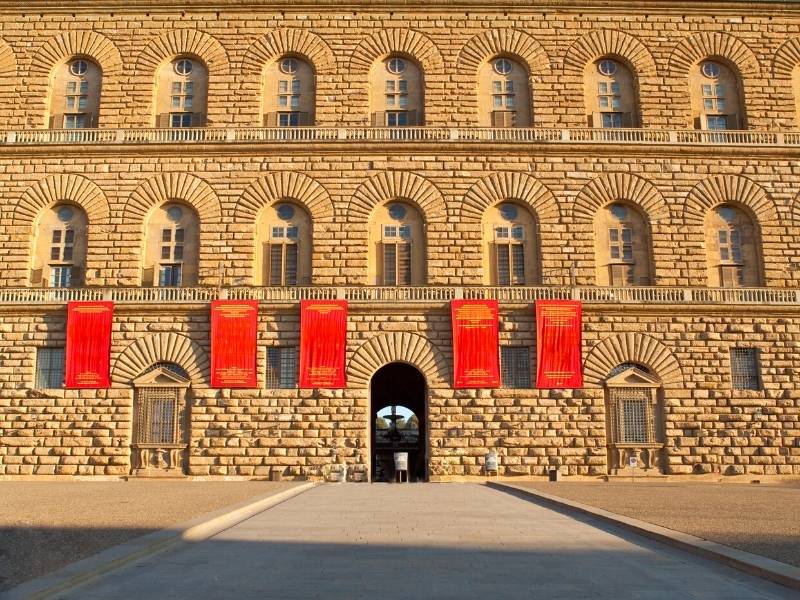

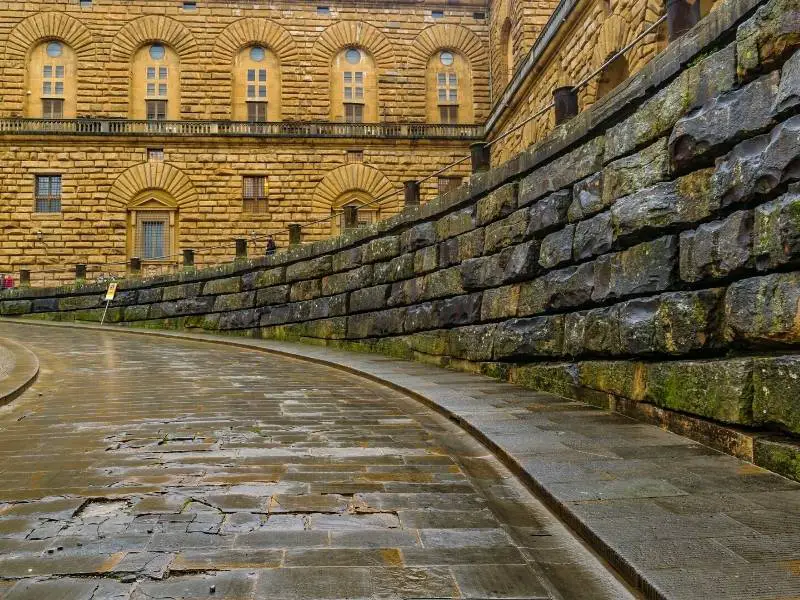
Fun fact: Palazzo Pitti, the largest museum complex in Florence, has 7 galleries inside its complex. But that’s not all. Its Palatine Gallery, the main gallery, houses more than 500 beautiful Renaissance paintings! That’s right, 500.
These masterpieces are stored in the 28 rooms of the Palatine Gallery and were created by famous Renaissance artists, including Correggio, Peter Paul Rubens, Pietro da Cortona, Raphael, Titian, and Perugino.
When you visit, you’ll come across a variety of paintings, mostly portraits and depictions of different personalities from the 15th to 17th centuries. The real showstoppers are the rooms themselves! The architecture, frescoes, and other decorations are simply breathtaking.
If you’re wondering which rooms to check out, I highly recommend the Hall of Mars, the Hall of Saturn, and the Hall of Venus in the Palatine Gallery. The frescoes and stuccoes on the ceilings of these rooms will leave you speechless and craning your neck to take it all in!
Personally, I was blown away by the massive frescoes in the Hall of Mars. Aside from Palatine Gallery, Palazzi Pitti’s other galleries are the Royal Apartments, Treasury of the Grand Dukes, Gallery of Modern Art, Costume Gallery, Carriages Museum, and Porcelain Museum. Based on their names, I know you already know what is exhibited in them.
Entry to Palazzo Pitti is free of charge for kids and teens below 18 years old. You can visit every week, aside from Mondays, from 8:15 am until 6:50 pm.
For adults, here are the ways you can visit Palazzo Pitti:
Palazzo Pitti is one of the most visited places in Florence. I recommend booking in advance before the tickets sell out. You may use the widget below to quickly book your entry passes:
If the widgets are not working you may book your visit to different attractions in Florence here.
Tip. Buy combination tickets for Palazzo Pitti, Boboli Gardens (the beautiful garden behind Palazzo Pitti), and Uffizi Garden (we’ll discuss next) to save some Euros. Learn about more deals, entry requirements, and other announcements from Palazzo Pitti’s website.
8. Uffizi Gallery
Artworks in Florence are amongst the most compelling expressions of the city’s beauty. They are a testament to the city’s world-famous cultural legacy, which has survived over time and can still be admired today.

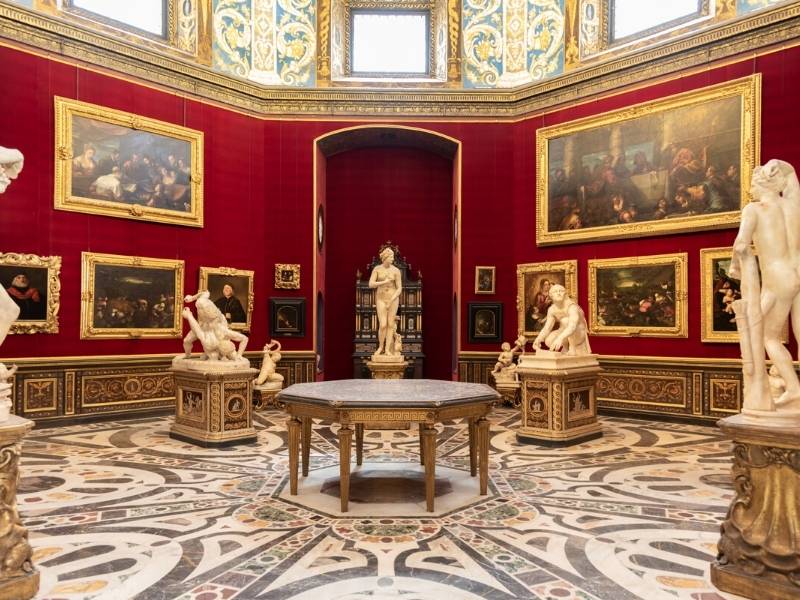
Do you know where you can find most of them? It’s in Uffizi Gallery. It’s this magnificent museum is home to more than 100,000 prints and drawings, paintings, antiques, and sculptures, and boasts the finest collection of Italian Renaissance art you’ll ever see.
You’ll find it nestled beside the Arno River and south of Palazzo Vecchio, and it’s conveniently located just a few steps away from this other must-see attraction in Florence. According to the official website of Uffizi, the artworks of the masters listed below are inside Uffizi Gallery:
- Giotto
- Simone Martini
- Piero della Francesca
- Beato Angelico
- Filippo Lippi
- Botticelli
- Mantegna
- Correggio
- Leonardo
- Raffaello
- Michelangelo
- Caravaggio
… and there’s a lot more! Other artworks were made by some European painters from Netherlands, Germany, and Belgium.
If you want to get a list of every artwork that you can expect to see from Uffizi, check out this link to the official website of Uffizi Gallery. However, I do not recommend you only see the masterpieces from your screens – to see them in person is a whole different experience!
If you’re an art enthusiast, Uffizi Gallery is the perfect paradise for you! When I was going through reviews of the gallery, I found that some art admirers have spent almost 48 hours there, and still felt like they needed more time! However, for ordinary travelers like myself, 3 to 4 hours of a visit should suffice to see most of the best artworks in Uffizi.
If you want to know the masterpieces you shouldn’t miss, here’s a list.
- First, The Birth of Venus by Sandro Botticelli. This enchanting painting transports you to a magical realm where Venus, the goddess of love and beauty, emerges from the sea. The intricate details and vibrant colors create a scene that’s truly out of this world.
- Next, we have Bacchus by Caravaggio. This painting captures Bacchus, the god of wine, in all his sensual glory. The contrast between his warm, radiant body and the dark background adds an element of drama to the scene.
- Then there’s Annunciation by Leonardo da Vinci. This painting depicts a tender moment between the Virgin Mary and Archangel Gabriel. The angel kneels before Mary, offering her a lily – a symbol of the Annunciation. The earthly setting adds a touch of realism to this divine encounter.
- Moving on, Venus of Urbino by Titian. This painting is an allegory of marriage and serves as a teaching model for eroticism, fidelity, and motherhood. Titian’s use of color and light brings Venus to life, making her seem almost tangible.
- Next up is Doni Tondo by Michelangelo. This painting features the Holy Family in a dynamic composition that gives it a spiral movement. It laid the foundations for Mannerism.
- Statue of Saint Lawrence by Gian Lorenzo Bernini. This sculpture depicts Saint Lawrence in a way that reflects Bernini’s mature style. The saint’s face shows how it’s possible to transcend pain through contact with God.
- Also, Medusa by Caravaggio. Painted on canvas applied to a wooden shield, this artwork is said to be a self-portrait of Caravaggio when he was younger.
- Finally, The Tribuna, an octagonal room filled with sculptures and paintings from the Medici collection. This room is a testament to the grandeur and opulence of the Medici family.
Learn all the necessary details for your visit from the official website of Uffizi Gallery. But in short, Uffizi Gallery is open to visitors from Tuesday to Sunday, from 8:15 am until 6:50 pm. Teens and kids below 18 years old are free to enter.
For adults, you may book your entry to Uffizi Gallery and find more things to do in Florence here.
9. Galleria dell’Accademia
Florence is an incredibly beautiful city, with so many works of art and architecture that one day is not enough time to see it all. The number of masterpieces is truly unbelievable!
In addition to the previously discussed Uffizi Gallery, visitors must not miss the opportunity to explore the Galleria dell’Accademia. This gallery is packed with Renaissance masterpieces and is home to a massive collection of artwork created by Florentine artists.
It is actually Italy’s second most popular art museum, following the Uffizi Gallery, and is known as the “Gallery of the Academy of Florence.” The museum is famous for being home to Michelangelo’s original sculpture of David, which is truly a must-see for any art lover.
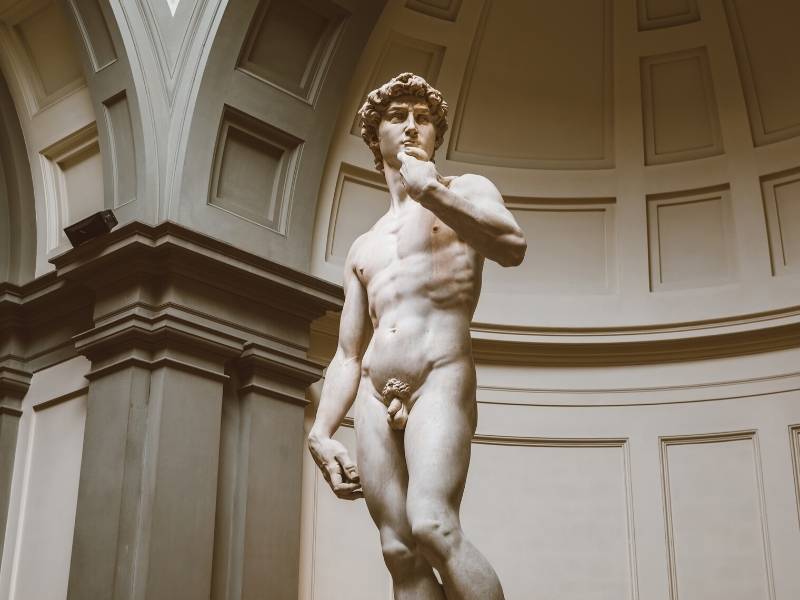
The gallery is located northeast of Piazza del Duomo, about a 6-minute walk through Via Ricasoli.
When you visit the Galleria dell’Accademia, you’ll find a wealth of artistic treasures beyond just the famous statue of David. Musical instruments and historical archives are on display, along with many other sculptures and paintings.
But let’s be real, the David is the star of the show. Seeing it in person is truly surprising, and I hate to spoil it, but the first thing that will likely catch your eye is its size. In pictures, it may look like an ordinary man, but in reality, this masterpiece stands a towering 517 centimeters (or 17 feet) tall!
To put that in perspective, Michelangelo himself was only 158 centimeters (or 5 feet 2 inches) tall. It’s truly wondrous how he was able to create such a masterpiece on such a grand scale.
Michelangelo’s attention to detail is beyond any praising words.
Focus on David’s hands, hair, eyes, and tensed muscles. All are sculpted with accuracy and precision – absolutely worth seeing!
The Galleria dell’Accademia is home to a vast collection of sculptures, including works by Giambologna and Gipsoteca, as well. While the Statue of David is the most famous sculpture on display, visitors should also take note of Lorenzo Bartolini’s Scorpion Nynpm, Emma and Julia Campbell, and La Riconoscenza.
Additionally, the gallery boasts a variety of Renaissance paintings from artists such as Filippino Lippi and Paolo Uccello, as well as works by Giotto, Giovanni da Milano, Agnolo Gaddi, and many others.
Galleria dell’Accademia is open from Tuesday to Sunday, from 9:00 am until 6:45 pm. You have to come at least 30 minutes before the closing time. Learn more visiting information from the official website of Galleria dell’Accademia.
Here are the ways you can enter and explore Galleria dell’Accademia. Click one to learn more.
Because Michelangelo’s statue of David is known everywhere, countless people from everywhere come to Galleria dell’Accademia. Literally, you can often find long lines of people on the counter wanting to enter Galleria dell’Accademia. Skip the line by booking online using this widget:
10. Abbazia di San Miniato al Monte
Florence has yet another reason why it’s such a beautiful place to visit – Abbazia di San Miniato al Monte. This unique abbey and church boast a facade with stunning architecture and design that echoes Florence Cathedral, Basilica Santa Croce, and Basilica Santa Maria Novella.
What’s more, the abbey is perched atop a hill, offering visitors an unparalleled view of the historic city center of Florence. However, the real standout feature of Abbazia di San Miniato al Monte is its choir, which is raised on a platform above the large crypt, setting it apart from other churches in the area.
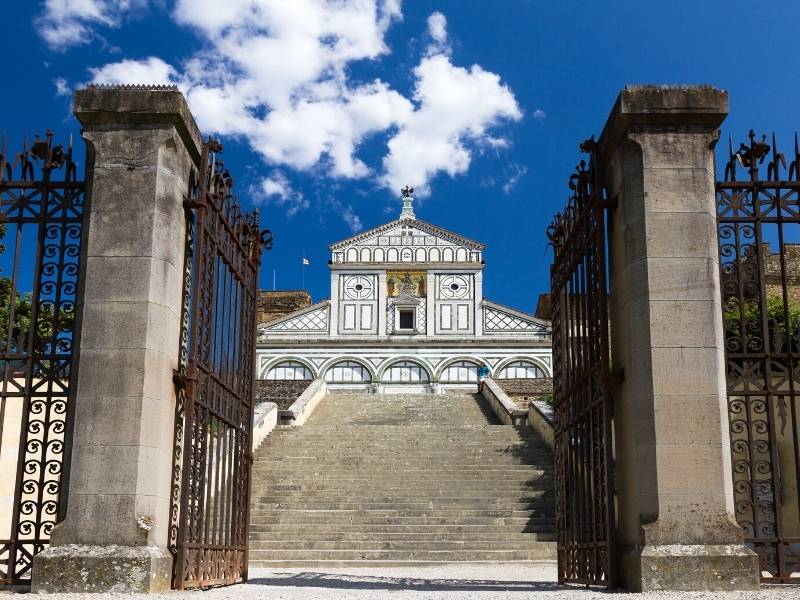
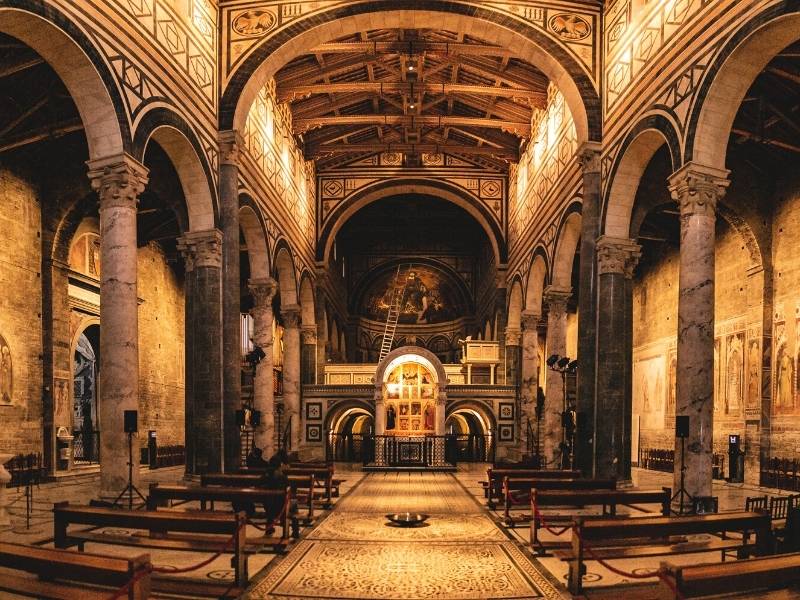
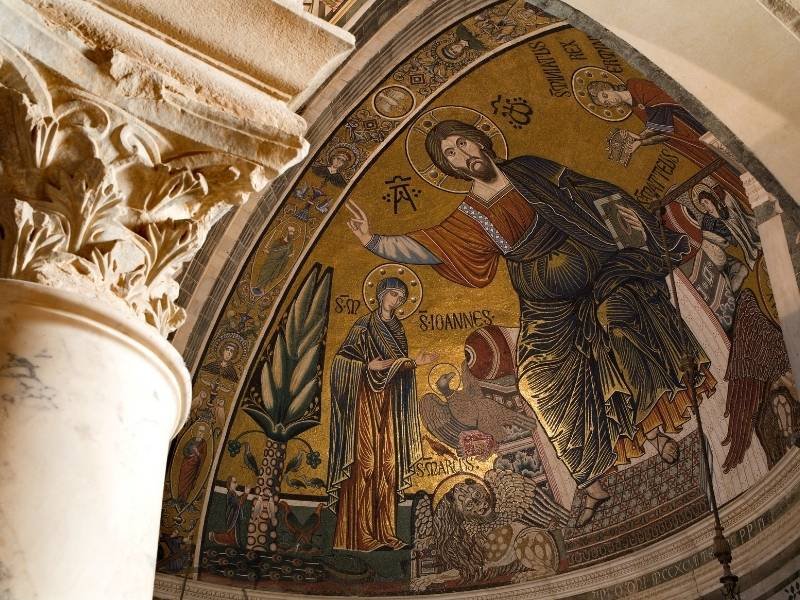
However, when you visit Abbazia di San Miniato al Monte, you’ll notice something different from the other churches we’ve mentioned earlier. Unlike them, the interiors of this church match its facade in style.
Above the arches, walls are adorned with geometric patterns, while the altar and choir also feature interesting designs. For photographers seeking a dramatic shot, the primary portal of the church is the perfect spot. Step back a bit, face towards the entrance, and capture the dotted door as part of the frame for the stunning views of the city in the distance.
Anyhow, Abbazia di San Miniato al Monte has a plethora of unique features that are sure to captivate visitors. For instance, the raised choir and “presbytery” with an early 13th-century Romanesque pulpit are both remarkable.
The church also boasts several admirable frescoes, some of which were created by Taddeo Gaddi and can be found in the vaults of the crypt. In addition, the sacristy has frescoes depicting the life of Saint Benedict, a masterpiece painted by Spinello Aretino.
However, as you step into the church, the first artwork that is likely to catch your eye is the mosaic in the apse. Interestingly, the mosaic dates back to 1207 and depicts Christ in between the Virgin Mary and Saint Miniato, who holds the crown in the mosaic.
You also won’t want to miss the Cardinal of Portugal Chapel located to the left of the nave. This chapel is considered to be one of the most magnificent funerary monuments of the Italian Renaissance, and for good reason. It’s an absolute masterpiece of creativity, with a stunning mosaic floor, elegant ceiling, and superb frescoes that are sure to leave a lasting impression on you.
And if you’re lucky enough to catch the sunlight streaming through the windows, you’ll be treated to an even more breathtaking view.
Admission to the Abbazia di San Miniato al Monte is free. However, you have to travel a little far from the city center to get here. Here is the exact location of the church on Google Maps. Abbazia di San Miniato al Monte is open from 9:30 am to 1:00 pm and 3:00 pm to 7:00 pm from Monday to Saturday.
On Sundays, it opens a little early, at 8:15 am. See the Eucharistic celebration schedules and more visiting information from its official website.
Bonus: Piazzale Michelangelo
In addition to Abbazia di San Miniato al Monte, Piazzale Michelangelo is another awe-inspiring spot that offers a panoramic view of Florence’s historic center. This 19th-century square sits atop a hill and allows visitors to soak in the entire cityscape from above.
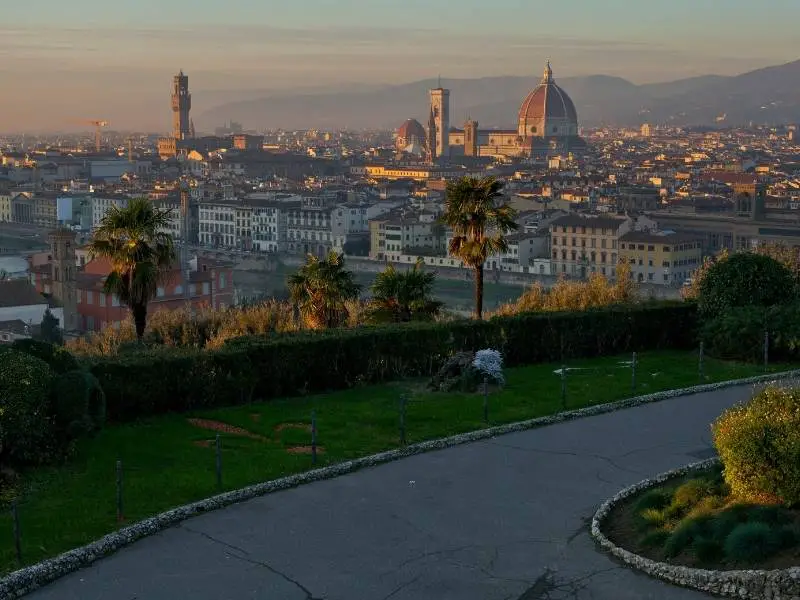
If you’re someone who always seeks out beautiful scenic spots in a city, then Piazzale Michelangelo is the perfect destination for you. From here, you’ll be able to enjoy stunning views of several iconic landmarks in Florence – perhaps even every beautiful place we discussed previously.
The panorama from Piazzale Michelangelo stretches from the medieval walls of Florence to River Arno, Ponte Vecchio to Basilica di Santa Croce, Palazzo Vecchio to Florence Cathedral, and all the way out to the rolling hills and mountains in the distance.
Trust me when I say that this is a view you won’t want to miss, especially during the sunset and golden hour.
Since it is a park or garden dedicated to Michelangelo, you can find replicas of his best artwork here, the Statue of David. The park has cafes too. The view plus the meals they offer should offer you one beautiful and memorable relaxing experience in Florence.
Hey there, can I share something with you? Do you feel the same way as I do? I absolutely adore cities that offer panoramic views, such as Florence. Whenever I take in that kind of scenery, it’s like I’ve soaked up everything I need to during my visit. If you’re interested, I can suggest some other European cities that boast impressive panoramic views.
- Lyon (from La Basilique Notre Dame de Fourvière): 14 Best Reasons Why You Should Visit Lyon
- Avignon (from Jardin des Doms): 10 Best Reasons Why You Should Visit Avignon
- Bern (From Rose Garden): 22 Best Things To Do In Bern
- Nuremberg (from Imperial Castle): 15 Reasons Why Nuremberg Is Worth Visiting
- Stuttgart (Stuttgart TV Tower): 10 Best Reasons Why You Should Visit Stuttgart
Alright, that’s a wrap! Those are some of the most stunning spots you can’t miss in Florence.
And if you’re planning a visit soon, why not treat yourself to one of these enlightening and peaceful tours? Just click on any of the activities below to find out more.
See all the best things to do in Florence now.
You might also want to check other places in Northern Italy which I find beautiful and worth visiting, too.
- Verona, Rome, Venice, Milan, and Bergamo—You can find more attractions similar to what Florence has.
- Do you like visiting scenic places where you can relax with the sea/lakes? Try Lake Como, Lake Garda, and Cinque Terre. You can also find stunning landmarks and historical sites in them.
- Is it the awe-inspiring and breathtaking destinations in Italy you want to see? You must be looking for Cortina d’Ampezzo, Bolzano, and Trento. You can also discover a culture with Italian, German, and Austrian influences from these places.
Best Time to Visit Florence
Florence is a city that’s always ready to welcome you, no matter the season.
Its stunning attractions and artworks are ever-present, waiting to be admired. You can visit them at any time of the year. However, there are a few things you might want to consider when planning your trip.
Overall… if you’re looking to catch the city at its best, consider visiting between May and September. This is when Florence basks in the glow of the Italian sun, and the city comes alive with art festivals and al fresco dining.
April, May, and October are also great months to visit. The weather is pleasantly warm, perfect for exploring the city on foot or by bike. Plus, the city isn’t as crowded during these months, and you’ll find that many museums and monuments extend their hours.
But don’t write off the winter months just yet! From November to March, Florence takes on a quieter charm. Museums and galleries are less crowded, making it a great time for art enthusiasts.
When To Visit for Best Sightseeing Experience in Florence
If you’re planning to do sightseeing and appreciate the architectural landmarks, the best time to visit is during the shoulder seasons of spring (April to June) and fall (September to October). These months offer mild, sunny days perfect for exploring.
During these times, you can enjoy the breathtaking views of the city from places like Piazzale Michelangelo and Forte Belvedere with clear skies. You can also appreciate the architectural marvels such as the Duomo, Ponte Vecchio, Palazzo Vecchio, and many others without the discomfort of extreme temperatures.
The city does heat up in July and August, making it a bit challenging to explore the city in the afternoon. On the other hand, it cools down in December and January which might require you to bundle up as you explore.
Planning a Budget Trip to Florence
If you’re looking to explore the beautiful city of Florence without breaking the bank, consider planning your trip between November and March. This is when Florence is less crowded, and the hotel rates are at their lowest, ranging from $58 to $152 per night (as of 2023)
On the other hand, if you were to visit during the peak season from April to June, you’d find yourself paying anywhere between $98 and $281 per night for a hotel. So, by choosing to visit in the low season, not only do you get to save some cash, but you also get to experience Florence in a more relaxed and intimate setting.
Just remember, the weather can be a bit unpredictable with a higher chance of rain, so pack accordingly!
You can find the best hotel deals in Florence here.
More Memorable Trip to Florence: Visit During Cultural Events
If you’re looking to soak up the local culture in Florence, timing your visit with a festival or cultural event is a fantastic idea.
Here are three events to consider:
- Cinema Chiardiluna: Fancy a movie night, Italian style? This event takes place in the Isolotto – Legnaia area of Florence. It’s a great chance to dive into Italian cinema and get a taste of the city’s thriving arts scene. This event usually kicks off in mid-June and runs until early September.
- Festival dei Popoli di Firenze: Held in November, this festival is all about celebrating the people of Florence. Held in the Duomo area, it’s a wonderful opportunity to mingle with locals and learn about their traditions.
- Manifattura Tabacchi Firenze: This isn’t your average cultural event. The Manifattura Tabacchi is an old tobacco factory that’s been transformed into a cultural hotspot, hosting various events throughout the year. The dates can vary, so it’s best to check their event calendar closer to your visit.
Here’s Florence’s Calendar of Events.
When’s The Worst Time to Visit Florence
If you’re planning your first trip to Florence and want to make sure it’s a memorable one, you might want to avoid: Peak tourist season (July to August). This is when Florence sees the highest influx of tourists.
The city can get extremely crowded, making it difficult to fully appreciate the beauty and charm of Florence. The lines for popular attractions like the Uffizi Gallery and the Florence Cathedral can be incredibly long, and restaurants and cafes in the city center can be packed.
It’s like you’re standing in a sea of people, trying to catch a glimpse of the stunning Ponte Vecchio or waiting for hours to get into the Uffizi Gallery. Not ideal, right? That’s what Florence can be like during the peak tourist season.
This could potentially detract from your overall experience.
How Long to Stay in Florence
It’s a tough call when it comes to figuring out how much time to spend in Florence because everyone’s interests and preferences are different.
If you’re on a tight schedule or just want to see the main sights, then a day or two should suffice. During your visit, you can check out the Uffizi Gallery and see some of the world’s most famous art, as well as the Accademia Gallery and marvel at Michelangelo’s David. You can also take a leisurely stroll across the Ponte Vecchio, a charming medieval bridge lined with shops, and visit the Duomo.
However, if you’re eager to soak up everything that Florence has to offer, then I suggest setting aside at least 3-4 days. This will give you plenty of time to explore not only the main attractions but also the city’s quaint back streets. You can shop for high-quality leather goods, indulge in delicious Tuscan cuisine (make sure you try Bistecca alla Fiorentina!), and visit other cultural treasures.
Don’t miss out on exploring Mercato Centrale or enjoying the city views from various viewpoints.
If you want to decide for yourself how long to stay in Florence, here are the average times that a traveler would spend at each attraction in the city. They should give you a clue on how much time you’d spend in Florence.
Please note that these are average times, and your visit may be shorter or longer depending on your interests. (based on the data from Tripadvisor reviews)
- Florence Cathedral: Most visitors spend an hour to two here.
- Baptistery: Plan for about 20-30 minutes here.
- Basilica of Santa Croce: takes about 1 to 2 hours to explore.
- Basilica of Santa Maria Novella: Expect to spend less than an hour here.
- Palazzo Medici Riccardi: A visit here typically lasts about 2 to 3 hours.
- Palazzo Vecchio (Hall of the Five Hundred): You’ll need about 1 to 3 hours to take in all the history and art in this massive hall.
- Palazzo Pitti: Takes about 1 to 2 hours to explore.
- Uffizi Gallery: You’ll want to set aside about 2 to 3 hours for your visit.
- Galleria dell’Accademia: This gallery typically takes about 1 to 2 hours to explore.
- Abbazia di San Miniato al Monte: 1 hour would be enough.
Where to Stay in Florence
Looking for a place to stay in Florence? Here are some tips:
- Historic City Center (Centro Storico): Imagine waking up and stepping out to see the Duomo, Uffizi Gallery, and Palazzo Vecchio right at your doorstep! That’s what you get when you stay in the heart of Florence. However, keep in mind that it can be crowded and a bit pricey.
- Santa Maria Novella: This area is super convenient as it’s near the main train station. It’s also close to several major attractions.
- Oltrarno: Love artisan workshops and antique furniture galleries? Then Oltrarno, located on the south side of the Arno River, is perfect for you. It’s also close to Palazzo Pitti and Boboli Gardens.
- San Spirito and San Frediano: If nightlife is your thing, these areas are full of hotels, bars, and restaurants.
For a budget-friendly trip to Florence, consider staying in the following areas:
- San Frediano: This neighborhood is known for its authentic Italian vibe and is a bit more affordable than the city center.
- Santa Croce: While still centrally located, Santa Croce can be a bit cheaper than the Historic City Center. It’s a lively area with many restaurants and bars.
- Suburbs of Florence: If you don’t mind taking public transport to reach the city center, the suburbs of Florence offer cheaper accommodations.
Here’s where you can find the best hotel deals in Florence.
How to Get to Florence
Now, let’s talk about how to get to Florence.
The closest airport to Florence is the Florence Peretola Airport, just a stone’s throw away from the city center. Once you touch down, you have a couple of options to get to the heart of the city. You can hop on the Line T2 tram, which will get you to Santa Maria Novella railway station in about 20 minutes.
If you’re already in Italy, getting to Florence is a breeze. The city is well-connected by train with other major cities like Rome, Milan, and Venice. You can also catch a bus. Once you’re in Florence, you’ll find that the city center is compact and easy to explore on foot. In fact, it’s a limited traffic area (ZTL), so driving isn’t really recommended.
But if you’re keen on venturing into the countryside, renting a car could be a good idea. Cities like Siena, Monteriggioni, San Gimignano, Lucca, Pisa, or Cinque Terre are all within reach.
Whether you need to rent a car really depends on your itinerary and personal preference. Many of these places are accessible by public transportation, but having a car can give you more flexibility.
Getting Around Florence
Walking is one of the best ways to see Florence, as it is one of the most walkable cities in the world.
The city was designed for walking, and you can discover hidden gems like chapels and artisan workshops on foot. Public buses and trams connect Florence airport, Santa Maria Novella train station, and other points of interest beyond the city center.
If you are feeling adventurous, renting a bicycle, e-bike, or Vespa scooter is a popular option among locals. Bike-sharing through Ridemovi is available, and shared e-bikes and e-scooters are a new trend.
Taxis are also available in Florence, but unlike in other major cities, they cannot be hailed on the street. You need to call one or go to a designated “taxi stop” to pick one up.
For more information in getting around Florence, please check the official website of Florence Tourism. This Map of Florence public transportation services can also be handy.
Save it on Pinterest.




